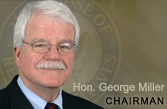






Press Releases
House Education & Labor Committee Passes Single Largest Investment in College Aid since GI Bill
|
||
|
Wednesday, June 13. 2007 |
||
|
WASHINGTON, DC -- The House Education and Labor Committee today voted 30 to 16 to approve legislation that would make the single largest investment in college financial aid since the 1944 GI Bill, helping millions of students and families pay for college – and doing so at no new cost to U.S. taxpayers. The full House will vote on the legislation next. The legislation, the College Cost Reduction Act of 2007 (H.R. 2669), would boost college financial aid by about $18 billion over the next five years. The legislation pays for itself by reducing excessive federal subsidies paid to lenders in the college loan industry by $19 billion. It also includes $750 million in federal budget deficit reduction. "Today's vote is a significant victory for America's students and their families. This legislation represents Congress's biggest effort since the GI Bill was passed more than 60 years ago to help Americans pay for college. We are committed to growing and strengthening America's middle class. A key to that goal is making sure that every qualified student can afford to go to college and this vote takes us a tremendous step in the right direction," said Rep. George Miller, the chairman of the committee and the sponsor of the legislation. "Not only does this legislation meet our promise of making college more affordable, but it does so in a fiscally responsible way, at no new cost to taxpayers. For far too long, college costs have grown faster than families' ability to pay them. With this bill, we are saying that help is on the way." Under the legislation, the maximum value of the Pell Grant scholarship would increase by $500 over the next five years. When combined with other Pell scholarship increases passed or proposed by Congress this year, the maximum Pell Grant would reach $4,900 by 2008 and $5,200 by 2011, up from $4,050 in 2006, thus restoring the Pell’s purchasing power. Over 6 million low- and moderate-income students would benefit from this increase. The legislation would cut interest rates in half on need-based student loans, reducing the cost of those loans for millions of student borrowers. Like legislation passed by the House earlier this year, the College Cost Reduction Act would cut interest rates from 6.8 percent to 3.4 percent in equal steps over the next five years. Once fully phased-in, this would save the typical student borrower -- with $13,800 in need-based student loan debt -- $4,400 over the life of the loan. About 6.8 million students take out need-based loans each year. The legislation would also prevent student borrowers from facing unmanageable levels of federal student debt by guaranteeing that borrowers will never have to spend more than 15 percent of their yearly discretionary income on loan repayments and by allowing borrowers in economic hardship to have their loans forgiven after 20 years. The College Cost Reduction Act includes a number of other provisions that would ease the financial burden imposed on students and families by the cost of college, including:
President Franklin Roosevelt signed the GI Bill into law in 1944. The original law enabled 7.8 million veterans of the second World War to participate in education or job training programs. A broad coalition of student advocacy groups and labor organizations support the key provisions of the College Cost Reduction Act, including increasing Pell Grant scholarship aid and lowering interest rates on need-based student loans. To see their letters of support from student associations, click here. To see letters of support from other organizations, click here. For a fact sheet on the legislation, click here.
FOR IMMEDIATE RELEASE |
2181 Rayburn House Office Building | Washington, DC 20515 | t: 202-225-3725
Site Map | Privacy Policy | Contact Us | Minority Site